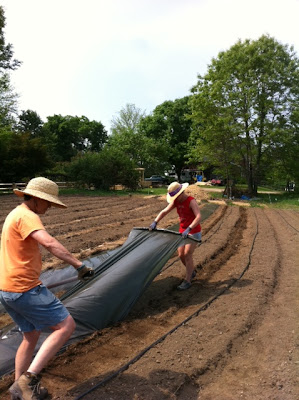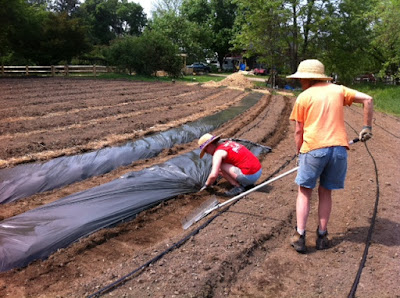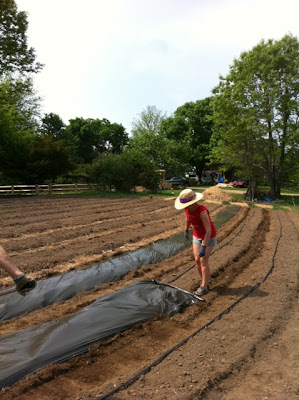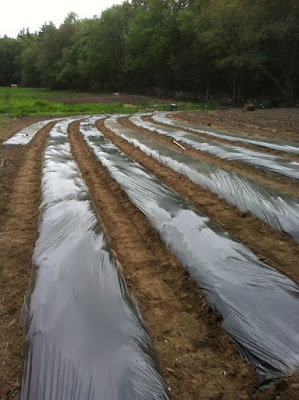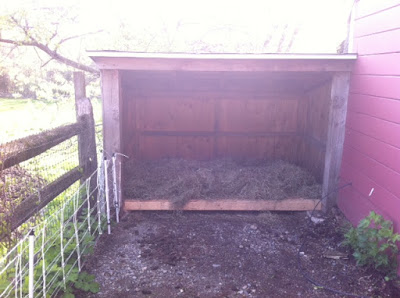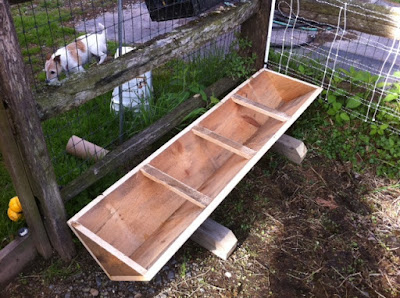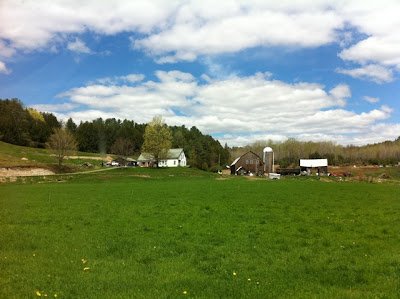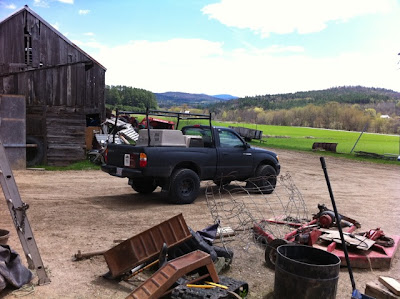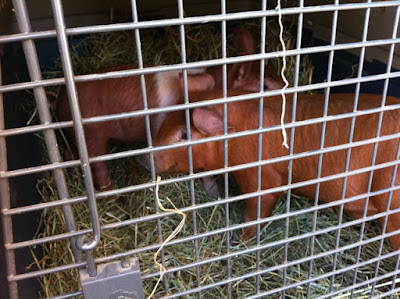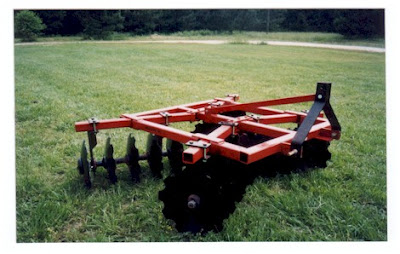Hello, blog readers. This is my first blog post ever. Gallagher has been threatening to rescind my ability to post for months, but I finally did it! Hopefully, I will get used to this and be a regular contributor in the future.
On Saturday I went to a fencing clinic at Wellscroft Farm in southern New Hampshire. There they operate both a working livestock farm and and a fencing company called Wellscroft Fencing Systems. They are very nice, very helpful, and extremely knowledgeable people. The owner, David Kennard, in addition to being a full time farmer and boarder collie breeder/trainer, is also the self-proclaimed “Portable Net Fencing KING of New England.” It was a great clinic and I learned A LOT about fencing in one day. When I told people I was going to an electric fencing clinic 1 1/2 hours away from the farm, the reactions were somewhat mixed. Most people were supportive, but some basically said, “why would you need to go to a clinic?” I am an electrician after all (albeit not a licensed one), and therefore the assumption is that I should be able to hook a stupid wire up to a fence and not electrocute myself too badly in the process. How hard could it be? This is somewhat true. The answer is that I did not go to the clinic to learn how a fence energizer works, or what the difference between voltage and amperage is. I luckily already understand these concepts. What makes fencing complicated and worth learning about, for me, is that there are so many different options and variations, so many ways to do it. And believe me, its very confusing and frustrating to design a fencing system if you have no experience with it. My reason for going to the clinic was to determine the best, most efficient (both in terms of work and cost) method for fencing my pigs and specifically what equipment I would need. I figured it would be easy one stop shopping. I’d sit and listen to a little sales pitch, ask some questions, and buy what I needed.

The clinic was surprisingly well attended—around 100 people showed up at 8:30 for coffee and donuts, followed by a fast paced talk by David Kennard on the basics of electric fencing. In 2 ½ hours he covered how fence energizers work, the different types of energizers (AC, battery, solar), grounding techniques, lightning protection, monitoring voltage and troubleshooting, training animals to the fence, different types of electric fencing (permanent, semi-permanent, and portable), and much more.

A few things that I took away from this talk:
-
Energizer all have the same basic internal components in that they all run off DC (direct current, e.g. batteries) power. The AC (alternating current, e.g. an outlet in your home) models simply have a rectifier built in and the solar models are simply DC battery powered units that have solar panels attached to to them. Many of the models can run off of AC or DC right out of the box. If you want to run it off a battery, you just need to buy a 12v deep cycle marine or regular car battery. If you want to run it solar, you need to buy a battery and a solar panel.
-
Animals need to be trained to the fence. The best way to do this is to set up the electric fence inside of an existing permanent fence or pen. Then you bait the fence leaving some grain or other food right on the other side of it. Once the animal gets a shock they will not test it again. It is especially important with pigs to train them with a wooden or wire fence behind the electric fence because pigs, unlike other animals, will often charge through the electric fence the first time they get a shock.
-
Grounding is extremely important. If your fence, clogged with weeds and grass, is a better ground than your actual ground rod, then you have a problem. The fence must be clean and you need at least one 4′ long galvanized steel ground rod driven, preferably into damp soil. The wetter the better. You can even ground straight into a pond if you have one nearby. Additional ground rods can be added as needed, but must be 10′ apart. And finally, all ground rods for your fence must me more than 30′ from your utility ground, or you will get electrical interference on your 120v system.
-
If you need to ground a portable system quickly, and don’t want to drive a rod 4′ into the ground, you can take a section of fence or of wire mesh, attach your ground wire to it, and then just throw it down flat on the grass. Just make sure not to touch it once the system is on.

After the talk, we took a tour of the farm and David showed us all of the different types of fencing in action. This was extremely helpful because it became more and more clear how beneficial electric fencing can be when it is set up extensively as a system to control the entire farm. David talked a lot about rotational grazing and how he has designed his fencing system with this model in mind. Rotational grazing is so important in any sustainable livestock model, and portable fencing is what makes it possible, both in terms of cost and labor, for small and large producers alike.
Intensive rotational grazing (IRG) is a pasture management technique that results in highly efficient usage of pasture as forage as well as restoration of nutrients to the soil and an increased biomass. Grazing animals are confined to a section of pasture for a brief period of time (the area and time are dependent on the type and number of grazers) while the other sections of pasture are allowed to rest. The idea is to find the right ratio of grazers to pasture size so that the forage is consumed at an even rate and the manure is evenly spread. If you put 5 pigs on an acre of land, then they are going to poop in one spot, eat some grass here and there, root up some spots here, and maybe not even touch some areas. But if you take those pigs and you put them in a 1/4 acre or even smaller, then they will start to graze, root, and spread their manure more evenly.
After the pasture is exhausted (but not destroyed), the animals are moved to another section and the previous section is allowed to recover. The animals are provided with unlimited fresh forage. The manure begins to break down and seep into the soil proving it with nutrients necessary to regrow. And if the timing is right, this process keeps going on and on. Its really a beautiful thing.
This system work with any ruminants or non-ruminants that can get a portion of their diet from forage. And it works especially well when you bring more than one type of animal into play. One of my favorite farmers, Joel Salatin, is the master of finding ways to achieve symbiosis on the farm, to have everything play its part and in doing so create a closed loop. After his cows have exhausted a section of pasture, they move on to another and he moves his laying hens onto the grazed down land. The laying hens forage for whatever is left and also pick apart the fresh cow patties looking for the insects that are already hatching inside them. This breaks the manure down so it can leech into the field more efficiently.

pigs enclosed in a small paddock using pig netting
For our 4 pigs, we have about an acre of pasture and probably 1 1/2 acres of woods. The plan that I have come up with after attending the clinic is to surround the entire area with a perimeter fence and then use net fencing specifically designed for pigs to segment it off into paddocks. The perimeter fence could and probably should be permanent fencing, ideally high tensile wire, but I don’t have the money for that. So I am going to install a semi-permanent fence using 2–3 strands of poly rope and I am going to run it through the woods using as many trees as possible as posts. The perimeter fence will run through the woods and then across the back of the pasture, through another section of woods and then back along the tree line, creating a big U shape. I will then use one or two lines of pig netting to create a narrow slice containing pasture and woods that will be about ¼ acre total. The best thing about creating the perimeter fence is that it becomes my power source. I can put the energizer at the beginning of the fence, which is close enough to an outlet to run it off AC, and then it will run all the way out though the woods to the far end of the field. So, when I set up my pig netting, all I need to do is clip it onto the perimeter fence and it is ready to go. I will post a map of the fencing plan soon.
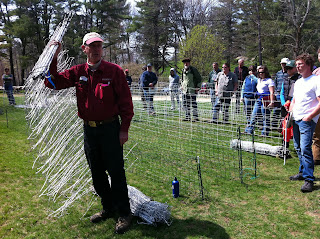
We are considering using electric fencing for the vegetable fields as well. We need to keep both small critters and deer out, so the plan is to use a 30” tall garden netting for the critters and then run 2 strands of electric tape above it to keep out deer. Small animals will not dig under electric fencing like they will under conventional wire fences because their first instinct is to test the fence before digging. Since I am already buying the fence energizer for the pigs, the cost of buying the fencing for the garden will certainly be cheaper than putting in a permanent fence and it comes with the added benefit of being able to take it down in the fall if we need to plow again.
